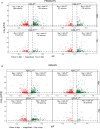Role of the histone variant H2A.Z.1 in memory, transcription, and alternative splicing is mediated by lysine modification
- PMID: 38366138
- PMCID: PMC11224360
- DOI: 10.1038/s41386-024-01817-2
Role of the histone variant H2A.Z.1 in memory, transcription, and alternative splicing is mediated by lysine modification
Abstract
Creating long-lasting memories requires learning-induced changes in gene expression, which are impacted by epigenetic modifications of DNA and associated histone proteins. Post-translational modifications (PTMs) of histones are key regulators of transcription, with different PTMs producing unique effects on gene activity and behavior. Although recent studies implicate histone variants as novel regulators of memory, effects of PTMs on the function of histone variants are rarely considered. We previously showed that the histone variant H2A.Z suppresses memory, but it is unclear if this role is impacted by H2A.Z acetylation, a PTM that is typically associated with positive effects on transcription and memory. To answer this question, we used a mutation approach to manipulate acetylation on H2A.Z without impacting acetylation of other histone types. Specifically, we used adeno-associated virus (AAV) constructs to overexpress mutated H2A.Z.1 isoforms that either mimic acetylation (acetyl-mimic) by replacing lysines 4, 7 and 11 with glutamine (KQ), or H2A.Z.1 with impaired acetylation (acetyl-defective) by replacing the same lysines with alanine (KA). Expressing the H2A.Z.1 acetyl-mimic (H2A.Z.1KQ) improved memory under weak learning conditions, whereas expressing the acetyl-defective H2A.Z.1KA generally impaired memory, indicating that the effect of H2A.Z.1 on memory depends on its acetylation status. RNA sequencing showed that H2A.Z.1KQ and H2A.Z.1KA uniquely impact the expression of different classes of genes in both females and males. Specifically, H2A.Z.1KA preferentially impacts genes involved in synaptic function, suggesting that acetyl-defective H2A.Z.1 impairs memory by altering synaptic regulation. Finally, we describe, for the first time, that H2A.Z is also involved in alternative splicing of neuronal genes, whereby H2A.Z depletion, as well as expression of H2A.Z.1 lysine mutants influence transcription and splicing of different gene targets, suggesting that H2A.Z.1 can impact behavior through effects on both splicing and gene expression. This is the first study to demonstrate that direct manipulation of H2A.Z post-translational modifications regulates memory, whereby acetylation adds another regulatory layer by which histone variants can fine tune higher brain functions through effects on gene expression and splicing.
© 2024. The Author(s).
Conflict of interest statement
The authors declare no competing interests.
Figures





Similar articles
-
Short-Term Memory Impairment.2024 Jun 8. In: StatPearls [Internet]. Treasure Island (FL): StatPearls Publishing; 2025 Jan–. 2024 Jun 8. In: StatPearls [Internet]. Treasure Island (FL): StatPearls Publishing; 2025 Jan–. PMID: 31424720 Free Books & Documents.
-
Systematic analysis of the effects of splicing on the diversity of post-translational modifications in protein isoforms using PTM-POSE.bioRxiv [Preprint]. 2025 Mar 27:2024.01.10.575062. doi: 10.1101/2024.01.10.575062. bioRxiv. 2025. Update in: Cell Syst. 2025 Jul 16;16(7):101318. doi: 10.1016/j.cels.2025.101318. PMID: 38260432 Free PMC article. Updated. Preprint.
-
H2A.X N-terminal acetylation is a newly identified NAA40-mediated modification that is responsive to UV irradiation.Epigenetics Chromatin. 2025 Jul 16;18(1):46. doi: 10.1186/s13072-025-00608-3. Epigenetics Chromatin. 2025. PMID: 40665417 Free PMC article.
-
Signs and symptoms to determine if a patient presenting in primary care or hospital outpatient settings has COVID-19.Cochrane Database Syst Rev. 2022 May 20;5(5):CD013665. doi: 10.1002/14651858.CD013665.pub3. Cochrane Database Syst Rev. 2022. PMID: 35593186 Free PMC article.
-
Psychological interventions for adults who have sexually offended or are at risk of offending.Cochrane Database Syst Rev. 2012 Dec 12;12(12):CD007507. doi: 10.1002/14651858.CD007507.pub2. Cochrane Database Syst Rev. 2012. PMID: 23235646 Free PMC article.
Cited by
-
The "Ins and Outs and What-Abouts" of H2A.Z: A tribute to C. David Allis.J Biol Chem. 2025 Feb;301(2):108154. doi: 10.1016/j.jbc.2025.108154. Epub 2025 Jan 4. J Biol Chem. 2025. PMID: 39761855 Free PMC article.
-
PTBP1 crotonylation promotes colorectal cancer progression through alternative splicing-mediated upregulation of the PKM2 gene.J Transl Med. 2024 Nov 4;22(1):995. doi: 10.1186/s12967-024-05793-5. J Transl Med. 2024. PMID: 39497094 Free PMC article.
-
Histone variants: expanding the epigenetic potential of neurons one amino acid at a time.Trends Biochem Sci. 2025 Jun;50(6):532-543. doi: 10.1016/j.tibs.2025.03.015. Epub 2025 Apr 22. Trends Biochem Sci. 2025. PMID: 40268580 Review.
-
The role of abnormal epigenetic regulation of small GTPases in glioma (Review).Int J Oncol. 2025 Aug;67(2):63. doi: 10.3892/ijo.2025.5769. Epub 2025 Jul 4. Int J Oncol. 2025. PMID: 40613212 Free PMC article. Review.
-
Multifunctional histone variants in genome function.Nat Rev Genet. 2025 Feb;26(2):82-104. doi: 10.1038/s41576-024-00759-1. Epub 2024 Aug 13. Nat Rev Genet. 2025. PMID: 39138293 Review.
References
MeSH terms
Substances
Grants and funding
- R35 GM137833/GM/NIGMS NIH HHS/United States
- RGPIN2020-06911/Canadian Network for Research and Innovation in Machining Technology, Natural Sciences and Engineering Research Council of Canada (NSERC Canadian Network for Research and Innovation in Machining Technology)
- RGPIN-2015-05115/Gouvernement du Canada | Natural Sciences and Engineering Research Council of Canada (Conseil de Recherches en Sciences Naturelles et en Génie du Canada)
- PJT-156414/Gouvernement du Canada | Canadian Institutes of Health Research (Instituts de Recherche en Santé du Canada)
LinkOut - more resources
Full Text Sources
Medical
Molecular Biology Databases
Research Materials
Miscellaneous

